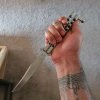- Joined
- Jul 5, 2016
- Messages
- 480
I think most lock types will do fine for most tasks, but I'll avoid certain knives for certain tasks. For instance, I won't use a knife with a thin liner lock to carve at wood. I've found that a framelock bar can slip sometimes when cutting cardboard and twisting when not cutting in a straight line. Backlocks can be a pain when working in an environment where dirt ends up getting into the knife. There are certainly examples of knives with those lock types that won't be an issue in those situations though (thicker liner, proper contour on framelock bar scale, tighter fit on lockback parts). In the end, if I want a knife I don't have to worry about beyond where I aim the edge I'll use a fixed blade.

